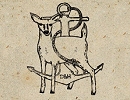Contact Seller
Doe And Hope
Tel07729 213013Please quote Antiques Atlas.


 Tridacna Gigantea Complete Giant Clam Shell
Tridacna Gigantea Complete Giant Clam Shell
 Large Ammonite Genuine Somerset Jurassic Ammonite
Large Ammonite Genuine Somerset Jurassic Ammonite
 Genuine Somerset Jurassic Ammonite Fossil
Genuine Somerset Jurassic Ammonite Fossil
 Decorative Cephalopod Fossil
Decorative Cephalopod Fossil
 Vintage Decorative Halved Ammonite, African Fossil
Vintage Decorative Halved Ammonite, African Fossil
 Vintage Carved Decorative Ammonite, African Fossil
Vintage Carved Decorative Ammonite, African Fossil
 Vintage Decorative Ammonite, African, Opalized
Vintage Decorative Ammonite, African, Opalized
 Set of Vintage Rare Earth Metals, Continental
Set of Vintage Rare Earth Metals, Continental
 Sale On. Natural Coral Specimen
Sale On. Natural Coral Specimen
 Sale On. Antique Coral Specimen
Sale On. Antique Coral Specimen
 Sale On. Natural Coral Specimen
Sale On. Natural Coral Specimen
 Sale On. Mushroom Coral Specimen
Sale On. Mushroom Coral Specimen
Non UK callers :
+44 7729 213013
Natural History Honey Bee Specimens


1 of 3
The specimens, preserved in formaldehyde within a cylindrical glass capsule, the label in latin reading ‘Apis Mellifica’ and ‘Honey Bee Life History’ with further makers label for T Gerrard & Co Ltd, Pentonville Road, London. The life history of the bee is displayed chronologically and is labelled with the ‘Larvae’, ‘Pupae’, ‘Worker’, ‘Drone’, ‘Queen’ and finally the ‘Brood Comb’.
The specimens, and the capsule it resides in, are in fine condition with no cracks or loss. There are some loose particles suspended in the formaldehyde, which is entirely normal. The capsule may or may not be a later replacement though it is certainly of a high quality. The top Honey Bee label shows some wear.
T Gerrard & Co Ltd, Pentonville Road, preparators, technicians and modellers of London were involved, amongst other things, in biology, osteology and entomology. They moved to Preston, Angmering, Sussex as Gerrard & Haig Ltd in the 1970's. Later they were aquired by Griffin & George, before that firm was itself taken over by Fisons Scientific.
Unlike a bumble bee colony or a paper wasp colony, the life of a honey bee colony is perennial. There are three castes of honey bees queens, which produce eggs drones or males, which mate with new queens and have no stinger and workers, which are all non-reproducing females. The queen lays eggs singly in cells of the comb and larvae hatch from eggs in three to four days. They are then fed by worker bees and develop through several stages in the cells. A colony may typically consist of tens of thousands of individuals.
Development from egg to emerging bee, as we see illustrated, varies among queens, workers and drones. Queens emerge from their cells in 16 days, workers in 21 days and drones in 24 days with only one queen usually present in a hive. The virgin queen takes one or several nuptial flights and once she is established starts laying eggs in the hive. Each unfertilised egg contains a unique combination of 50% of the queen's genes and develops into a haploid drone. The fertilised eggs develop into either workers or virgin queens. The average lifespan of a queen is three to four years drones usually die upon mating or are expelled from the hive before the winter and workers may live for a few weeks in the summer and several months in areas with an extended winter.
A valuable and highly absorbing piece of natural history, especially with the bee now under threat in the twenty first century, its life cycle that we see preserved and displayed here, now in danger of being brought to an abrupt end.
The shipping of this fragile item is through a bespoke service and is reflected in the price
SellerDoe And Hope
View all stock from
Doe And Hope

 Private dealer, By appointment only
Private dealer, By appointment only
The Onion Barn, Shoe Cottage,
15 High Street, Blunham,
Bedfordshire, MK44 3NL.
MK44 3NL
Tel : 07729 213013
Non UK callers : +44 7729 213013
Get directions to Doe And Hope
The specimens, and the capsule it resides in, are in fine condition with no cracks or loss. There are some loose particles suspended in the formaldehyde, which is entirely normal. The capsule may or may not be a later replacement though it is certainly of a high quality. The top Honey Bee label shows some wear.
T Gerrard & Co Ltd, Pentonville Road, preparators, technicians and modellers of London were involved, amongst other things, in biology, osteology and entomology. They moved to Preston, Angmering, Sussex as Gerrard & Haig Ltd in the 1970's. Later they were aquired by Griffin & George, before that firm was itself taken over by Fisons Scientific.
Unlike a bumble bee colony or a paper wasp colony, the life of a honey bee colony is perennial. There are three castes of honey bees queens, which produce eggs drones or males, which mate with new queens and have no stinger and workers, which are all non-reproducing females. The queen lays eggs singly in cells of the comb and larvae hatch from eggs in three to four days. They are then fed by worker bees and develop through several stages in the cells. A colony may typically consist of tens of thousands of individuals.
Development from egg to emerging bee, as we see illustrated, varies among queens, workers and drones. Queens emerge from their cells in 16 days, workers in 21 days and drones in 24 days with only one queen usually present in a hive. The virgin queen takes one or several nuptial flights and once she is established starts laying eggs in the hive. Each unfertilised egg contains a unique combination of 50% of the queen's genes and develops into a haploid drone. The fertilised eggs develop into either workers or virgin queens. The average lifespan of a queen is three to four years drones usually die upon mating or are expelled from the hive before the winter and workers may live for a few weeks in the summer and several months in areas with an extended winter.
A valuable and highly absorbing piece of natural history, especially with the bee now under threat in the twenty first century, its life cycle that we see preserved and displayed here, now in danger of being brought to an abrupt end.
The shipping of this fragile item is through a bespoke service and is reflected in the price
Price The price has been listed in British Pounds.
Conversion rates as of 30/JAN/2025. Euro & Dollar prices will vary and should only be used as a guide.
Always confirm final price with dealer. Phone or visit the website to buy, Free UK shipping.
DimensionsDiameter 3.5 inches (at maximum)
Height 9.75 inches
Category Natural History
Date c.1880-1910
Late Victorian Antiques Material Glass
Origin British
Maker T Gerrard & Co Ltd
Condition Very Good.
Item code as155a516
Status Sold
£265.00 
$330.38 
€316.70 

$

€

Conversion rates as of 30/JAN/2025. Euro & Dollar prices will vary and should only be used as a guide.
Always confirm final price with dealer. Phone or visit the website to buy, Free UK shipping.
View all stock from
Doe And Hope

 Private dealer, By appointment only
Private dealer, By appointment onlyThe Onion Barn, Shoe Cottage,
15 High Street, Blunham,
Bedfordshire, MK44 3NL.
MK44 3NL
Tel : 07729 213013
Non UK callers : +44 7729 213013
Get directions to Doe And Hope
You may also be interested in
 Tridacna Gigantea Complete Giant Clam Shell
Tridacna Gigantea Complete Giant Clam Shell
 Large Ammonite Genuine Somerset Jurassic Ammonite
Large Ammonite Genuine Somerset Jurassic Ammonite
 Genuine Somerset Jurassic Ammonite Fossil
Genuine Somerset Jurassic Ammonite Fossil
 Decorative Cephalopod Fossil
Decorative Cephalopod Fossil
 Vintage Decorative Halved Ammonite, African Fossil
Vintage Decorative Halved Ammonite, African Fossil
 Vintage Carved Decorative Ammonite, African Fossil
Vintage Carved Decorative Ammonite, African Fossil
 Vintage Decorative Ammonite, African, Opalized
Vintage Decorative Ammonite, African, Opalized
 Set of Vintage Rare Earth Metals, Continental
Set of Vintage Rare Earth Metals, Continental
 Sale On. Natural Coral Specimen
Sale On. Natural Coral Specimen
 Sale On. Antique Coral Specimen
Sale On. Antique Coral Specimen
 Sale On. Natural Coral Specimen
Sale On. Natural Coral Specimen
 Sale On. Mushroom Coral Specimen
Sale On. Mushroom Coral Specimen





